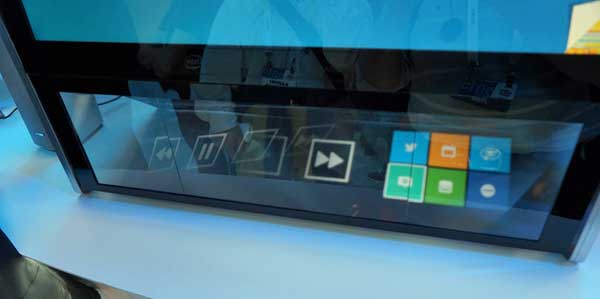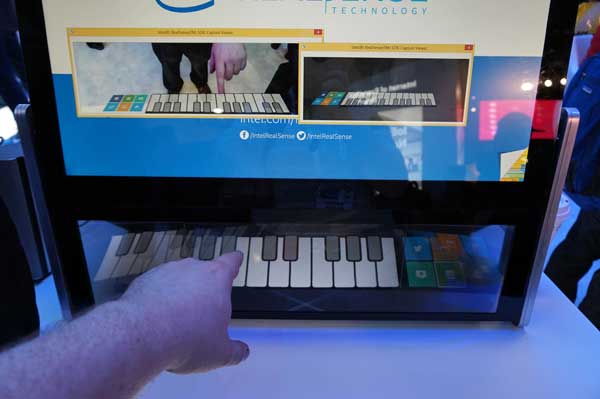Watch Intel's Wild Holographic PC Concept in Action
At its CES booth, Intel demonstrated one extraordinary use of its new RealSense 3D camera, accepting input on a holographic navigation panel that appears in mid-air.
LAS VEGAS - Help me Intel; you're my only hope! With the first computers packing its RealSense camera appearing at CES, Intel pulled out all the stops to show just what its depth-sensing, 3D technology can do. Amongst all the gesture control, gaming and face detection demos at the chipmaker's booth, one blew us away: an All-in-One PC with a holographically projected navbar that appeared to hover in mid-air, adjacent to the lower bezel.
In a brief hands-on, we found the holographic panel bright, colorful and responsive. Because the computer's RealSense camera was pointed downward at the nav bar, it was able to detect when we had pressed the buttons with great accuracy. Though it was very easy to target the buttons, the software was smart enough not to register presses that were too far above or below the keys vertically. Every time we hit a key correctly, a white box appeared around it to show that we were successful.
MORE: Dell Inspiron 23 All-in-One Touts RealSense Camera
The hologram was extremely vivid and sharp when viewed head on, but viewing angles were narrow and the image started to fade away as we moved more than 45 degrees to the left or right. When were just a couple of feet away or at a particularly wide angle, the nav bar disappeared entirely.
We saw a set of 6 buttons on the right side of the navbar, each representing different functions, including Twitter, a calendar, an outerspace app, a weather display, a media player and a piano keyboard. When we tapped each button, the content on the left side of the projection changed to the appropriate mode. Throughout our hands-on, a small window on the desktop showed a video feed of the hologram and our hands touching it.

In the outerspace mode, a map of planets appeared and allowed us to zoom in and out on the solar system. In the Twitter mode, we had the ability to send a tweet, but no virtual keyboard for writing it. The media player mode gave us pause, play and fast forward buttons, which controlled a video on the computer's display.
The most impressive application was the virtual piano keyboard, which allowed us to play a song just by hitting the holographic keys. As we tickled the virtual ivory, the window on the desktop showed what we were playing.
Get instant access to breaking news, the hottest reviews, great deals and helpful tips.

The demo is designed to show off the RealSense camera's gesture detection so Intel had few details on the holographic projection or how it works. An Intel rep told us that the projection technology was made by a small Japanese company, but offered few details beyond that.We hope to learn more about this exciting technology in the future.
